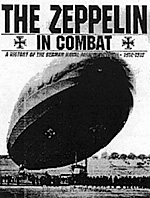 The Zeppelin in Combat by Douglas H. Robinson, Schiffer Military/Aviation History, 1994, 410 pages, ISBN: 0-88740-510-X, $49.95
The Zeppelin in Combat by Douglas H. Robinson, Schiffer Military/Aviation History, 1994, 410 pages, ISBN: 0-88740-510-X, $49.95
If you are willing to spend a few dollars, this book is the best one ever printed on WW I and the role of the Zeppelin. Others cover the entire war, and others say more about the naval use of the airship, but The Zeppelin in Combat is told from a uniquely personal side by a writer who can bring this little-known tale to life.
At the beginning of World War I, before it was even callet "The Great War," Germany was the leader in airship technology. Count Zeppelin had overcome a series of spectacular failures to interest the German government and the Kaiser in his designs. The General Staff, although not fully committed to the Zeppelin, recognized its use as a scouting platform - and as a bomber.
The German air attack over England in 1940 should, by rights, be called "The Second Battle of Britain." Over several years during the Great War, Germany expended tremendous effort to bring the war to British soil, while the British expended consiterable resources to defend themselves.
In 1914, the idea of dropping explosives on people from airships was a new and horrifying concept. The idea had been discussed in both the civilian and the professional press. Thus when Germany was blockaded (as she expected) and stalemated on the battlefield (which she did not), she looked for some other way to come to grips with her enemy.
Dr. Robinson highlights the role of Fregattenkapitan Peter Strasser, the first head of the German Airship Service and as much a visionary as Fertinand von Zeppelin. Strasser agitated for the bombing of England, and especially London, as a way to hit the military, economic, and psychological art of the British people. He believed that the raids would cause great damage, and perhaps even cause the collapse of an England already strained by war on land and sea.
Robinson knows his topic as well as anyone alive. He was inspired as a five-year-old boy when USS Shenendoah flew over his house (I wish I could have seen that). In addition to being an excellent researcher and writer, Dr. Robinson speaks fluent German, and managed to interview many of the members of the Zeppelin survivor's association. This personal viewpoint on the raids is vital to understanding the reasons for them being made, how they were carried out, and their effect, both on the British and the Germans.
Dr. Robinson examines the political and technical issues as well as giving a detailed account of each raid over England. The book's illustrations are spectacular, with photos of three- and four-Zeppelin fleets approaching the English coast, and a Zeppelin caught in English searchlights as it flies over London. In addition to technical descriptions of the various Zeppelins that served, there is an excellent glossary, providing extensive descriptions of airship technology.
Other Book Review
BT
Back to The Naval Sitrep #10 Table of Contents
© Copyright 1997 by Clash of Arms.
This article appears in MagWeb (Magazine Web) on the Internet World Wide Web.
Other military history articles and gaming articles are available at http://www.magweb.com